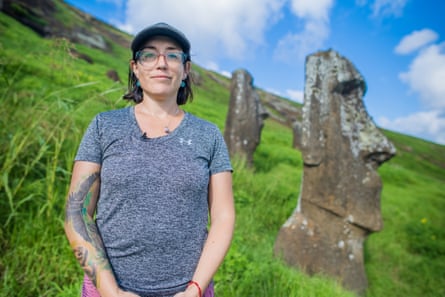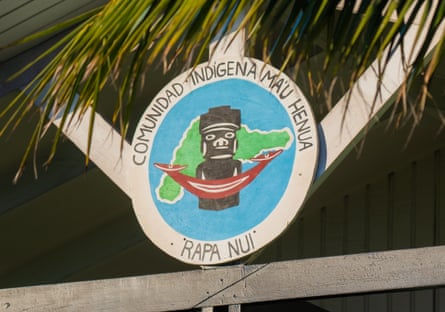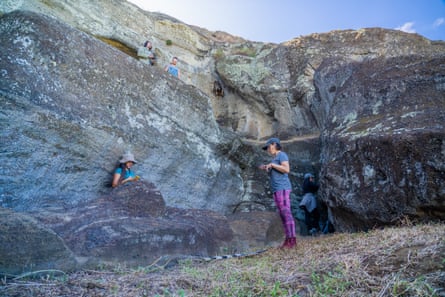‘Moai designs are getting lost’: extreme weather chips away at Easter Island statues
The Ahu Tahai moai, on the east side of Rapa Nui, also known as Easter Island, is an impressive 4.5 metres high. Carved from a soft volcanic rock, the statue looks out solemnly over the island, with its back to the bay.
The Tahai (“where the sun sets”) and the island’s other thousand or so moai were erected roughly between 1100 and 1700 as a representation of Rapa Nui’s ancestors.
The stoic monoliths have watched over battling Polynesian clans, endured the plundering of colonisers and survived reckless treatment by the British – who allegedly shot at the moai for target practice while renting the island for sheep farming in the 1900s.
Yet the statues’ latest adversary could be their most significant: the climate crisis. Ahu Tahai’s face has gradually lost its original features, including the cut of the nose and the sockets of the eyes. Its hands, once prominent, are now smoothed into the body.

“The designs are getting lost due to the erosion of the rock layers,” says Daniela Meza Marchan, a conservator for the Ma’u Henua Indigenous community, who look after the island’s sacred archaeological sites.
Over the past three decades, the island has experienced a significant reduction in rainfall, with heavier downpours occurring more sporadically. “We have much more extreme weather than before,” Meza Marchan says. “Periods of a lot of rainfall, followed by extended periods of drought.”
This torrential rain has a devastating effect on the moai, which are carved from soft volcanic rock called tuff, “a material that, by nature, is susceptible to damage, eroded by the wind and ionised by rain”, she says.
Meza Marchan restores the most damaged moai by cleaning off invasive micro-organisms such as lichen and moss, and applying a specialised treatment to strengthen the stone, followed by a water repellant to protect it from rain damage.
It is an expensive process made even more complicated by a strained relationship between Rapa Nui residents and the government 2,300 miles (3,700km) away in Chile, which annexed the island in 1888.

Shipping specialist conservatorial products from Italy to the remote Pacific island is excessively costly due to Chile’s import taxes, which are “even more expensive than the products themselves”, according to Meza Marchan.
The last time Meza Marchan conducted moai conservatorial work was in 2017, on Ahu Huri a Urenga – the only moai with four hands. The work took three months and was carried out jointly with Italian specialists from the Istituto Lorenzo de’ Medici, Chile’s national forestry service and the Indigenous community.
Other significant conservatorial tasks have included the restoration of Ahu Tongariki, 15 moai statues on the eastern side of the island, between 2003 and 2006. This was to make good botched restoration efforts in the 1990s, in which some statues were misplaced and non-traditional techniques were used. The project, funded by Unesco and Japan, included restoring the ahu, or altar, on which the moai are erected, and waterproofing the statues.
Projects are now supervised by the Ma’u Henua people, ensuring that they meet strict quality criteria. The local community is responsible for selecting the sites that most require urgent attention, but must get permission from Chile’s national monuments council, which falls under the government’s culture ministry.

“They ask for many specifications, so we’ve worked with only a few moai so far,” says Meza Marchan. “We need a [more urgent] programme.”
The conservator’s next project is to repair a large number of moai damaged by a wildfire in 2022.
The blaze ripped through 100 hectares (247 acres) of the national park, charring dozens of the statues. Historic levels of drought led to its rapid spread to become one of the most catastrophic wildfires on the island – another consequence of the climate crisis.
Chile’s budget for world heritage site conservation has quadrupled since last year to 690m pesos (about £600,000). It will be split between 15 projects across Chilean territories, with a portion allocated to restore five moai damaged by the fire. However, there are no plans to preserve rapidly eroding figures such as the Ahu Tahai.
Pilar Vicuña, Unesco’s cultural director in Santiago, praises the Chilean government for increasing the budget to restore the moai, but she echoes Meza Marchan’s concerns.
“Collaboration only happens on certain projects [such as the fire],” she says. “We need a conservation strategy to advance bit by bit.”

Vicuña says a proposed cultural heritage bill could help to speed up such programmes, which rely on a conservatorial process that has not been updated since the 1970s.
“The national monuments council is in a critical situation,” she says. “All permissions and projects happen very slowly.”
The bill is designed to ease strains on the centralised national monuments council and focus “on the active participation of Indigenous communities and peoples”.
But some people are wary of the project. Bety Rapa has worked as a tour guide in Rapa Nui for more than 30 years. “We still don’t have the final information about what’s going to come of it,” she says.
She has seen the deterioration of the moai first-hand and knows time is running out.
“Everyone here asks why there isn’t a permanent conservation plan, but we get drip-fed resources,” she says. “The state profits from the moai; they have a tourist attraction. Yet there is no real interest in protecting them.”
She gazes up at the weathered face of the Ahu Tahai. “The moai are more than just something decorative,” she says. “They are the image of our ancestors.”
Source: theguardian.com



